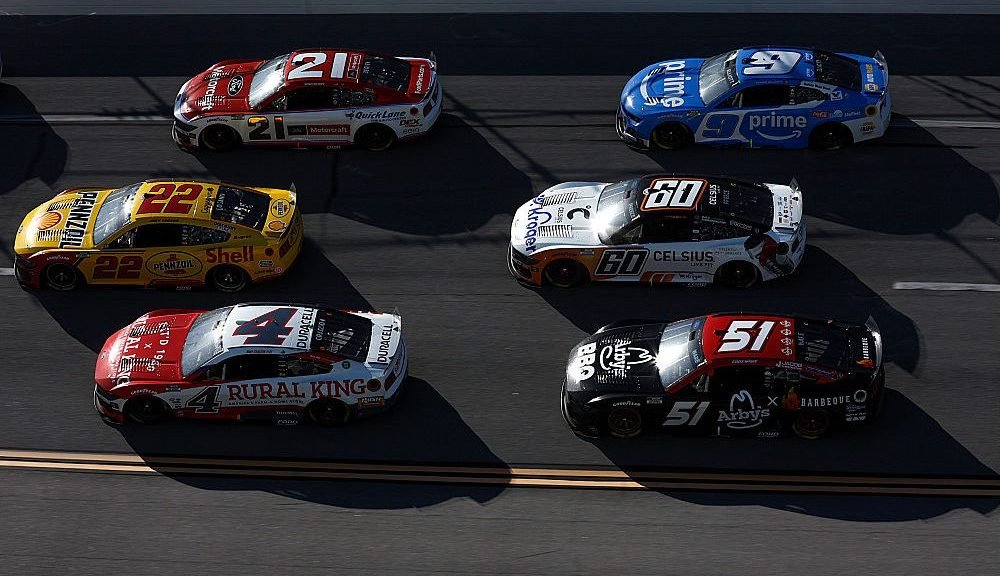Preece and Logano Face Disqualification at Talladega Superspeedway
In a dramatic turn of events during the Jack Link’s 500 at Talladega Superspeedway, both Ryan Preece and Joey Logano encountered disqualifications following the race. Preece, who had crossed the finish line in second place, was just 0.022 seconds behind the winner, Austin Cindric. However, his No. 60 RFK Racing Ford Mustang did not pass the crucial post-race inspection.
According to the NASCAR Rule Book, specifically section 14.5.8.F, which pertains to the requirements for the spoiler, Preece’s car had an extra shim installed. The regulations stipulate that a car should only have two shims on the spoiler, but Preece’s team had mistakenly added three. This error led to a significant penalty, ultimately relegating Preece to 38th place in the final standings.
Joey Logano, another prominent figure in the race, finished fifth, which would have marked his first top-five finish of the current season. However, his No. 22 Team Penske Ford Mustang also failed the post-race inspection due to issues related to the spoiler. In accordance with sections 14.5.8.E and 14.1.P of the NASCAR Rule Book, it is mandatory for a vehicle to have fasteners on the spoiler at all times. Unfortunately for Logano, his car was found to be missing a crucial spoiler bolt. As a result, Logano was demoted to 39th place, the last position in the finishing order.
Both disqualifications highlight the strict adherence to NASCAR regulations and the significant consequences teams face when these rules are not followed. The post-race inspections serve as a critical checkpoint to ensure that all cars comply with the established guidelines, promoting fairness and safety in the sport.
The Talladega Superspeedway, known for its high-speed racing and dramatic finishes, has long been a favorite among fans and drivers alike. The unique characteristics of the track create an environment where split-second decisions can lead to incredible outcomes, but they also demand the utmost precision from the teams. The disqualifications of Preece and Logano serve as a stark reminder of the importance of meticulous preparation and attention to detail in NASCAR racing.
As the season continues to unfold, teams will undoubtedly reflect on the lessons learned from this race. The consequences of missteps, like those that Preece and Logano experienced, can have lasting impacts on championship standings and team morale. For drivers and crew members, the pressure to adhere to every regulation is immense, especially as they compete for valuable points throughout the season.
Moving forward, fans and analysts will be keenly watching how both drivers and their respective teams respond to this setback. Preece and Logano are well-known for their competitive spirit and resilience, and their ability to bounce back will be essential as they navigate the challenges of the upcoming races. The NASCAR community often rallies behind drivers during tough times, and both Preece and Logano have a strong fan base that will support them as they aim for redemption in future events.
Additionally, this incident raises questions about the role of technology and engineering in modern NASCAR racing. With teams increasingly relying on advanced tools and strategies to gain a competitive edge, the margin for error becomes razor-thin. The complexities involved in car setups, including spoiler adjustments and other aerodynamic considerations, demand a high level of expertise and precision. As teams analyze their performance post-race, they will need to assess not only the mechanical aspects but also the human factors that contributed to the disqualifications.
In the world of NASCAR, every race is an opportunity for teams to showcase their skills and strategies. The competition is fierce, and even the smallest miscalculation can lead to significant consequences. As the Jack Link’s 500 demonstrated, the path to victory is fraught with challenges, and drivers must remain vigilant in their adherence to rules and best practices.
The disqualifications of Preece and Logano will likely be a topic of discussion among fans, commentators, and fellow drivers in the weeks to come. The implications of these rulings extend beyond the immediate race results, impacting the overall dynamics of the championship race. With each race, teams are not only vying for individual victories but also for the long-term success that comes with consistent performance and adherence to regulations.
In summary, while the Talladega Superspeedway race may not have ended favorably for Ryan Preece and Joey Logano, it served as a reminder of the unpredictability of NASCAR racing. The rigorous standards set forth by NASCAR ensure that all competitors are held to the same level of accountability, fostering a competitive yet fair racing environment. As the season progresses, teams will undoubtedly learn from these experiences, striving to improve their performance and avoid similar pitfalls in the future.
For fans of NASCAR, the excitement of each race lies not only in the competition on the track but also in the narratives that unfold behind the scenes. The highs and lows experienced by drivers like Preece and Logano add depth to the sport, making it a captivating spectacle for enthusiasts. As they prepare for the next challenge, both drivers will be focused on reclaiming their standings and demonstrating their capabilities on the racetrack, ensuring that the pursuit of victory remains at the forefront of their efforts. The journey continues, and the road ahead is filled with potential and promise for both Preece and Logano as they navigate the complexities of NASCAR racing.
